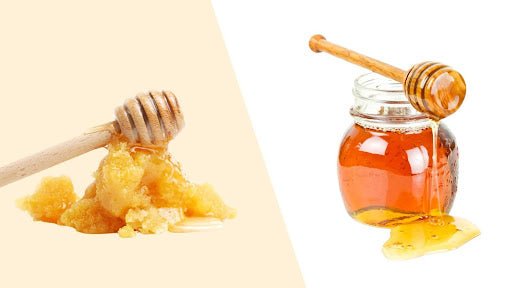

Why Does Honey Crystallize? (And Why That’s Actually a Good Thing)
If you’ve ever opened a jar of honey to find it thick, grainy, or even hard as a rock—don’t despair. Your honey hasn’t gone bad. In fact, crystallization is a sure sign that you’ve got pure raw honey—the good stuff (read about 10 Health Benefits of Raw Local Saskatchewan Honey). Plus, there’s a way to restore it to its smooth liquid state without ruining it. Let’s explore what crystallization really means, why it happens, and how to work with it.
WHAT IS HONEY GRANULATION
Honey is made up of natural sugars—mostly glucose and fructose. Over time, the glucose can start to separate from the water content in honey and form tiny crystals. This causes the honey to thicken or turn grainy. Crystallization often starts slowly, with the honey becoming cloudy, then gradually more granular.
WHY DOES HONEY GRANULATE?
Crystalization, also known as granulation, is a completely natural process that will happen to any raw unpasteurized or unfiltered honey. Pure Canadian honey naturally contains tiny bits of pollen, wax, and propolis—these act as "seeds" that crystals form around, which is actually a good sign it hasn't been overly processed. Glucose content, storage temperatures, and filtration during processing and packaging are all factors that may influence the formation of crystals and granules in your honey. Honey with higher glucose content (like clover or dandelion honey) will crystallize more quickly. Storing the honey in a cool place, or in the fridge, will also make those granules form up more quickly. .
CRYSTALIZED OR GRANULAR HONEY IS NOT SPOILED
Here’s the good news: crystallized honey is 100% safe to eat. It hasn’t spoiled, gone stale, or lost its flavour or nutritional benefits. In fact, many people prefer it in this state—it’s easy to spread on toast, spoon into tea, or use in baking. Crystallized honey is a sign of quality and purity. It’s wonderfully spreadable and packed with enzymes and antioxidants!
HOW TO LIQUIFY RAW HONEY WITH A WATERBATH
Some folks just don't like the mouthfeel of crystalized honey—that’s totally understandable!. If your honey has formed granules and you prefer it soft and pourable, you can bring it back to liquid form easily without damaging the flavour or nutritional benefits. There are a few ways to do this and here’s the easiest:
-
Place your sealed glass jar of honey in a bowl of warm water (around 95°F or 35°C). This can be a bowl of hot tap water on the counter, or a saucepan of water on the stove over LOW heat.
-
Let your sealed honey jar sit in warm water for 15–30 minutes, opening the jar to stir it occasionally until it’s all smooth.
-
You can repeat this process as needed without harming the honey.
When liquifying raw honey, the trick is to heat it gently without cooking or burning it. Avoid boiling or microwaving your raw honey—high heat can damage the raw honey’s natural properties and ruin the flavour.
SASKATCHEWAN’S BEST HONEY, NO MATTER WHAT TEXTURE
Now that you know all about why honey forms crystals and granules, you might even be glad when it happens to yours because you’ll know you have the best quality, pure, unfiltered local honey in your cupboard. You’re also equipped with the know-how to get it back to its smooth liquid consistency if you’re using it in sauces or infusions, or if you just love the way it drizzles when it's liquid. Either way, we’ve got you covered—find a retail location near you to get your hands on some of the best local honey around!